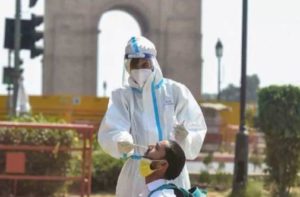
The Delhi Disaster Management Authority sounded the “yellow” alert under its GRAP on Tuesday. (Photo credit: PTI file)
The Delhi Disaster Management Authority sounded the “yellow” alert under its GRAP on Tuesday. (Photo credit: PTI file)
Omicron is gradually spreading in the community and the new, fast-spreading variant of concern has been found in 46 per cent of the latest samples analysed in the national capital, Delhi Health Minister Satyendar Jain said on Thursday.
He said stringent curbs have been put in place as part of the Graded Response Action Plan for COVID-19 to check the spread of the infection and the Delhi Disaster Management Authority (DDMA) will decide on implementing more restrictions.
“The latest genome sequencing report showed 46 per cent of the samples have Omicron. These people include those who do not have any travel history. It means Omicron is now inside Delhi,” Jain said.
“Indeed, the variant is gradually spreading in the community and its proportion will increase in the coming days,” the minister said when asked if Omicron will be the dominant variant in a possible third wave of the pandemic.
He also said that of the 200 coronavirus cases in Delhi hospitals, only 102 belong to the city. Also, 115 are those who were directly taken to hospitals from the airport.
Of the hospitalised COVID-19 patients in Delhi, 115 do not have any symptoms and have been kept in hospitals as a precautionary measure. None of the hospitalized patients is on oxygen support, Jain said.
The Delhi health minister had on Wednesday said many international travellers who tested negative at the airport are found to be COVID-19 positive after a few days. During this period, they are infecting their family members, he said.
“Delhi has imposed stringent curbs on gatherings, including weddings and funerals. Schools, gyms and spas have been closed, shops and malls will open on alternate days and metro trains and buses will operate at 50 per cent capacity… It is better to be precautious,” Jain said.
“A decision on more restrictions will be taken at a DDMA meeting,” he added.
He said countries like the US and France have recorded their highest number of daily COVID-19 cases amid the spread of Omicron “but the good news is that it does not cause severe infection and a very low number of patients need hospitalisation”.
The DDMA had on Wednesday decided that COVID-related restrictions imposed in Delhi under the ‘yellow alert’ will continue for the time being and authorities will monitor the situation for a while before deciding on fresh curbs.
On Tuesday, it had declared a ‘yellow alert’ under the Graded Response Action Plan in the city amid a spike in coronavirus cases following the emergence of the Omicron variant.
The ‘yellow alert’ entails restrictions like night curfew, closure of schools and colleges, the opening of shops selling non-essential items on an odd-even basis and halved seating capacity in Metro trains and buses, among other things.
The GRAP is based on positivity rate (on two consecutive days), the cumulative number of new cases (over a week) and average oxygenated-bed occupancy (for a week) for designated four levels of alerts.
After the ‘yellow alert’, further restrictions are imposed at advanced stages of ‘amber’, ‘orange’ and ‘red’ with a higher number of new cases and hospitalisations.
According to official figures, of the 8,965 dedicated COVID-19 beds in Delhi, 262 or 2.92 per cent were occupied and 97 per cent were vacant on December 28.




 Driving Naari Programme launched in Chandigarh
Driving Naari Programme launched in Chandigarh






























